The history of life on our planet is divided into “Ages”. There was the “Age of Fish” and the “Age of Reptiles”, and they say we are now in the “Age of Mammals” – actually more currently the “Age of Humans”. During each of those periods those life forms dominated the planet. They came in all sizes and lived in all habitats.
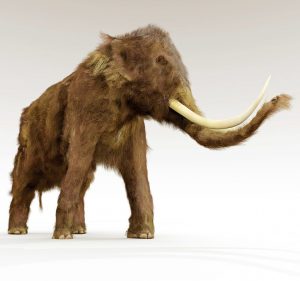
Image: Florida Institute of Technology
When the dinosaurs died out it was the small mammals that were around, and they managed to survive whatever it was that knocked the dinosaurs out. These small mammals were able to expand occupy niches left by the amazing reptiles. Somehow this past the birds. The mammals expanded in size, shape, and habitats. There were giant mammoths, bears, saber toothed tigers, and ant eaters the size of small horses. All of these beast ruled the land after the dinosaurs were gone.
We discussed in Lesson 3 how the endothermic birds gained an advantaged over the ectothermic reptiles. But the mammals took it another step forward. Birds have feathers. This insulates their bodies helping them maintain high body temperatures. The did use both Bergmann’s and Allen’s rules to assist with maintaining a high body temperature. But they were fliers and their hollow bones could only support so large a body. We know some dinosaurs were huge and occupied the niche of the “large and strong”. But the birds could not do this. Though the definitely became, and still are, the “Lords of the Air”, they could not dominate all niches. There were, and are, some attempts. The elephant bird was huge, and the ostrich is not small. These birds had solid bones and did not fly. But they could not compete with the giant mammals of the time.
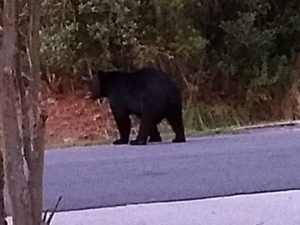
Photo: Mike Sandler
Mammals are also endothermic. Their scales modified into what we call hair – another good insulator. They obtained large size and adapted their extremities to meet the requirements of the environments they lived in. African elephants live in warm tropical climates. Though their bodies are large and, following Bergmann’s Rule, maintained a higher body temperature, they did not want to overheat in the African sun. Large ears (Allen’s Rule) releases heat and African elephants have much large ears than their Asian elephant counterparts, who live in cooler climates. The wholly mammoth took this to the next level and grew a lot of hair along with small ears, thus being able to live in more polar climates. African elephants do have hair but if you get close to one you will see they are there and well spread out. You do not need a fur coat in Africa.
There are dozens of examples of how the mammals used these principals to adjust to living on land and becoming the dominant creatures of the planet today. But there is more…
Their methods of producing young changed as well. Reptiles and birds lay eggs. Some in nests (all birds lay in nests) and some reptiles hold their eggs inside the parent’s body giving live birth. Some mammals still lay eggs, but most do not. One group, the marsupials develop their young within the womb which eventually crawls out into the pouch. At this time, their limbs are still “limb buds” and they literally grab hair on their mothers’ body and work their into the pouch where development finishes. Once widespread, they are now basically found in Australia and South America – one species, the opossum, lives in North America.
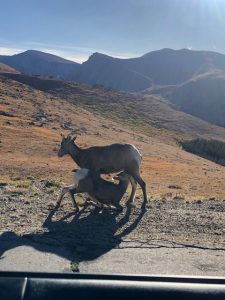
Photo: Molly O’connor
Today it is the placental mammals who rule. In this group the developing young does not crawl out and seek a pouch. The entire process is completed in the womb giving live birth. In the egg, birds and reptiles, the young feeds on yolk within the egg and goes to the restroom in a sack called the allantois. When the yolk is empty and the allantois full, it is time to hatch from the egg. Most of these young are left to fend on their own. With mammals there is a small yolk sack, but the developing young is connected to the mother’s placenta by an umbilical cord. This cord is full of blood vessels filled with the embryos blood. This blood passes over the placenta where food, oxygen, and waste are passed back and forth. So, no allantois here. The developing young gets rid of waste by diffusing it into the mother’s blood and she goes to the bathroom for them. The developing young is fully protected from the environment, and fed, by the mother. This system seemed to work very well, and the placental mammals are the dominant form found today.
But there is still more…
The brain of mammals is much larger (per body size) than other animals on this planet. They are more perceptive than many animals but so are sharks. The difference is what mammals can do with this information. This larger brain can hold and process tons of information from its surroundings. It can learn, and even teach other mammals, about dangers and which foods are safe to eat. However, the developing young cannot remain within the mother until the brain is fully developed – it would be too big. So, they are born ready to survive but their brains have more growing to do. Now the parents will stay with the developing young and teach them as their brain grows – childhood. This is not something we see a lot in other animals.
To feed these not yet fully developed babies mammals have mammary glands that produce a fat reach gland with which to feed the young. These young certainly cannot be left to survive on their own. Think about that… a human mother giving birth and leaving the infant in the woods to survive on its own. Not going to happen. These milk producing mammary glands are what give the animals their class name… Mammalia (mammals). If the young are successful and grow into older and mature adults, they will be a very alert and intelligent animals. And this is certainly an advantage.
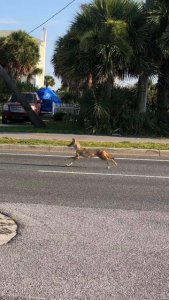
Photo: Shelley Johnson
And one more thing…
The use cursorial locomotion.
The early amphibians and reptiles did grow legs to walk on land, but those legs extended sideways of the backbone the same as the fins of a fish do. These legs extended laterally from the backbone and then, at the elbow, turned 90° down where the foot met the ground. This design forced them move their backbone side to side like a fish (try this in the activity below). They swing their bodies side to side swinging that large tail around to keep balance. Watch a video of an alligator walking to see how ambulatory location works. It does not work all that well and, if they need to run, it is relay hard. Though they can walk on land and do so for much (if not all) of their lives, they are much better swimmers in water.
The mammals on the other hand extend their limbs straight down from the backbone. When they walk their backbone does not go from side to side like an alligators, but rather up and down. Walking, and even running, on land using this cursorial locomotion is a definite advantage. The mammals have a lot of advantages.
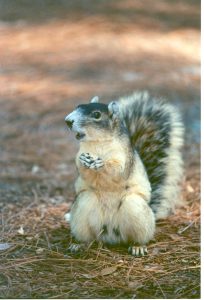
Photo Pinellas County Government.
There are about 7000 species of mammals on the planet today. Most live on land, but there are flying mammals (bats) and aquatic ones (otters, dolphins, and manatees). Mammals are divided into orders based on the number and type of teeth they have. As a group they are heterodonts (different teeth). There are the incisors for cutting, molars for chewing, and canines for grabbing and displaying force. It is really the molars that are used for dividing animals into orders. Sharp blade-like molars are found in the carnivores, which includes members of the dog and cat families. There are the flat ridged molars of the herbivores which include the deer, buffalo, and giraffe. Then there are molars that are in between these two. These are omnivores and can feed on both like bears, hogs, and humans. Over the “Age of Mammals” different species have roamed, grazed, or killed to stay alive. Being endothermic they have spread to all corners of the world including the poles. But some retuned to the sea – the marine mammals.
The fossil record suggests that all the marine mammals we know today did come from ancient land ancestors. Some did return to the sea and became swimmers, but they did not lose their cursorial form of location. You can see this when you watch a dolphin or manatee swim. Their “tails” (actually called flukes) move up and down as compared to a fish’s which goes side to side (ambulatory). Though fish are reptiles are very fast in the water with their ambulatory locomotion, the mammals are also fast. They lost nothing here. Over the years, members of their group became even more fish like. Genetic changes (due to mutations) created offspring that more resembled fish. These were even faster at catching prey and avoiding predators. These genes were selected for and over millions of years, they became almost fish looking – the dolphins. They even sport a dorsal fin!
Today there are four different orders of marine mammals. Let’s take a look.
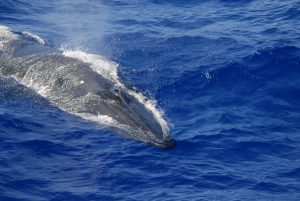
Photo: NOAA
Order Cetacea
The cetaceans are what we call the whales and dolphins and are what most people think of when they think of marine mammals. There are about 90 species of cetaceans in the world’s oceans. Most are salt water but there are a few species of freshwater, or river, dolphins.
There are 76 kinds of toothed whales (Odonticetes). These do have teeth but, unlike most mammals, they are homodonts – only having canine like teeth. Lacking molars, they cannot chew so toothed whales must cut their feed into small pieces or select small enough prey to swallow whole – much like the reptiles.

Image: NOAA
The largest of this group is the sperm whale. They reach about 60ft long and can weigh up to 100,000 pounds (50 tons). These giant toothed whales feed on fish and squid but also hunt the giant squid. This has never been seen but scientists imagine an amazing battle in the depths when this happens. The sperm whales can dive to depths of 10,000 feet and hold their breaths for up to an hour and half! (yes, mammals have lungs and must hold their breath while diving). They have a sophisticated SONAR system called echolocation. Using the air within their lungs they can produce low frequency sounds that resonate through a fatty tissue in the head called a melon. These low frequency sounds can travel great distances under water. They eventually hit an object and “echo” back to the whale which detects this with a hallow part of their lower jaw that also contains fat. These echoes not only tell the sperm whale if there is an object at 10,000 feet but many scientists believe they can tell what is, like a giant squid, and a large piece of nothing.
Once detected the sperm whale begins its deep dive going after the unknowing squid. Once the squid detects the whale it is probably too late. There are probably times when the squid does detect it soon enough to jet away, but many times it is completely surprised. The only thing it can do now is extend its arms and tentacles and grab the head of the sperm whale. Without arms, the whale now has to snap its mouth back forth with its 150 conical canine teeth trying to grab the squid. If no luck, it will eventually have to return to the surface for a breath. The squid will let go for another day.
How do they know this might be happening? Sperm whale were a popular target in the whaling industry. Whales lack the hair found on most mammals but make up for that loss of insultation by having thick layers of fat – blubber. This insulates JUST as well. This blubber was boiled down by the ancient whalers into oil and used for burning the many lanterns that lit the 19th century cities. It was said that whale ships smelled so bad from this boiling, which they would do at sea, that they had to dock at the end of the wharf and attend their own bars. They stunk! But many times, the heads of these whales they captured had the sucker scars from the giant squid. Many whales had these suggesting these great battles do go on. Measuring the diameter of these scars gave marine biologists an idea of how large these giant squid are.
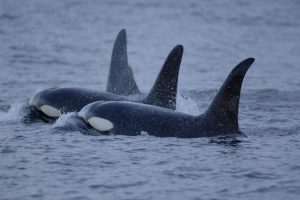
Photo: NOAA
There are other toothed whales. The Orca (killer whale) are considered to be apex predators, the wolves of the sea. But there are no reports of unprovoked Orca attacks on humans. There are plenty on some of the animals in the ocean including seals, sharks, dolphins, and even the large baleen whales. Many Orca’s feed on simple fish and squid. They form large social groups called pods. These pods usually have a few adult males, many adult females, and the young – not that different than their land mammal cousins like bison and caribou. They use high frequency sounds produced by the air in their lungs to communicate with each other. All sorts of squeaks, clicks, whistles, and wines come from them. Marine biologists believe they are speaking to each but have no idea what they are saying. There are biologists who study this trying to decipher the code.
Many of these Orca pods have 30 or so members. Once in a while there several pods that will join together and form “super-pods”. And then there are the smaller pods. 10-15 members. Usually moving slowly through the ocean without making any communication sounds at all. These were once called transient pods and marine biologists believe these are the Orcas who hunt the large prey – sharks, whales, and dolphins. They remain silent because their prey can hear them. So, no talking.
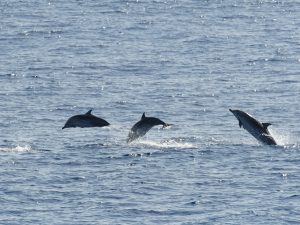
Photo: NOAA
The Orca’s and sperm whales are the larger of the toothed whales, most are much smaller, 10-20 feet long. They are either dolphins or porpoise. The difference is in the shape of their teeth. Dolphins have conical shaped teeth. Porpoise are more spade shaped. Both travel in pods, communicate with high frequency sounds, and hunt using echolocation. Some toothed whales can actually change the frequencies of the of their echolocation and use it as a stun gun – stunning their prey with sound and then going over and eating them. There are plenty of studies and stories on how intelligent dolphins are. I could tell a few, but we will skip and move on. Read about them, they are amazing.
The big whale – the ones you think of when you say “whale” are the baleen whales (Order Mysticete). Mysticete means “mustache mouth” and describes the large stiff hairs they have on their upper jaws (baleen), there is nothing on their lower jaw. Many species have pleated throats that allow them to engulf thousands of gallons of seawater. Once the water is in their cavernous mouth, they force it back out through the baleen, which collects tons of small fish, invertebrates, and minute plankton. Many feed on a small shrimp called krill and these shrimp are massively abundant in the polar waters of the world. The baleen whales include some of the largest creatures that have lived on this planet. Humpbacks, Gray whales, Sei whales, and right whales are all mysticetes. One, the blue whale, is the largest creature that has ever lived on this planet. They reach 100 feet long and weigh 300,000 pounds (150 tons!). These majestic beast were not the target of the ancient whalers. They had NO way to pull them in. In the 20th century the explosive harpoon was developed for whaling. The harpoon not only killed the whale but filled it with gas. Now the blue whales would float and large factor ships with large doors that would open and haul the large whales inside to be processed. All whales were targets then.

Photo: NOAA
Today this is not a common practice any longer. For one, we have electricity and the sale of whale oil was not needed. So, the whalers turned to selling their meat for food and fertilizer. However, with international pressure the whaling industry is all but gone.
As mentioned, whales and dolphins are placental mammals. They do give birth at sea and several females participate in the process. Once the baby is born, they must get it to the surface for its first breath and the females work as a team to make sure this happens – and predators stay away. The do feed their young milk and the mammary glands are found hidden along their stomach line. When junior wants a milk meal, they tap the mothers side asking, she stops – rolls sideways – and exposes her mammary glands where the baby will the drink. Dolphin/Whale milk is much fattier than ours (or cows – since we drink cow’s milk).

Photo: NOAA
Order Pinnipedia
The pinnipeds are the animals we call the seals and sea lions. The name “pinniped” means “feather foot”, which I guess their feet do look like feather? I guess… either way – that is what they are called. Pinnipeds are found on many coasts around the world and were once found in the Gulf of Mexico. The Gulf species, the Caribbean Monk Seal, is now believed to be extinct.
These animals are heterodonts and have blade like molars similar to dogs and cats. They are carnivores feeding primarily on fish but will take invertebrates like crabs and octopus. The large-tusked walrus feed on clams from the seabed.
The difference in seals and sea lions is the presence of an external ear flap. The ear is actually an internal organ within your head. The flap of skin we call an “ear” is called a pinnae and funnels sound down to the ear. If a pinniped has a pinnae, it is a sea lion. If it lacks this, it is a seal. If it has two large canine tusk like an elephant, it is walrus. Another difference is the position and design of the hind feet. The sea lions are better adapted for walking on the beach. They do not walk as well as you and me, but they walk much better than a seal or walrus. Seals and walrus sort of “lumber” across the beach.
These marine mammals also have a form of echolocation, but it is nowhere as well developed as the cetaceans. These are also placental mammals but do not give birth at sea. Rather, pinnipeds come ashore in large rookeries for both breeding and birth. There are HUGE fights between males for the right to mate. These fights are noisy and can be dangerous. The pups are born on the beach and, like other mammals including cetaceans, enjoy a childhood as their brains grow and develop.
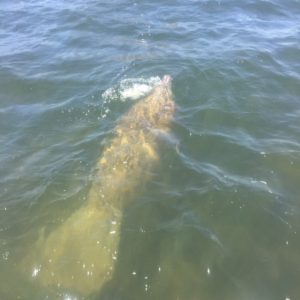
Photo: Marsha Stanton
Order Sirenia
Manatees resemble seals and sea lions but are not in the same order. Orders of mammals are defined by the number and type of teeth remember? Manatees do not have sharp blade like molars. Theirs are flat and ridged – they are herbivores and eat seagrass. The number of teeth suggest their closest land mammal relative is the elephant. Elephants have a modified upper lip that is called a trunk and can be used to grab plants to pull into their mouths so the flat-ridged molars can do their job. Unlike cows and horses, they lack incisors and so must use their trunk to do this. Manatees are similar. They lack a trunk but have large upper lips to grab and tear plants from the seafloor to eat.
The name sirenia means “mermaid” and was given to the animal when first viewed by the Spanish explorers to Florida thinking they were mermaids…. yep. Florida is one of the few places you can find manatees. There are four species: the African manatee, the Amazonian manatee, the West Indian manatee (the one we find in Florida), and the Dugong of Australia. They now believe that the West Indian manatee is two subspecies: the Florida manatee and the Antilles manatee.
Though mammals, the do get cold. Cold stress is a common cause of death for these animals. They are actually tropical, and Florida is at the edge of their thermal range. Many manatees die during the cold winters in this state. To survive this, many will migrate south to the Keys or the Everglades, find warm water springs in central Florida, or hang out behind power plants discharging warm water. Though mammals and possess larger brains than most other kinds of animals, manatees are not the swift moving marine mammal of dolphin fame. Boat strikes in Florida are another common cause of death in these animals.
They do give birth in the water like cetaceans, but the mammary glands are found under her arm pits. Unlike cetaceans, mother manatees do not have to slow their forward movement to feed their young. She can feed on the run.
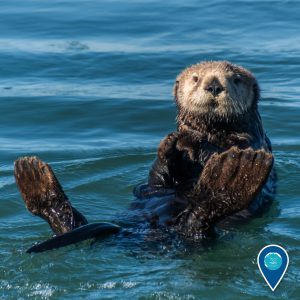
Photo: NOAA
Order Carnivora / Family Mustelidae
The last two marine mammals are both in the Order Carnivora. They have the same blade like molar as dogs, cats, and seals but belong to different families.
The mustelids are weasels, and their marine mammal member is the sea otter. This extremely smart and playful animal is common off the west coast of the United States and Canada. Once hunted to almost extinction for their furs, they have enjoyed a great come back. Their fur is so thick that it forms air pockets and allows them not only to stay dry but to float while resting at the surface. They dive for a variety of invertebrates like mollusks and echinoderms. They probably would grab a fish if the chance presents itself. They are famous for using tools to crack open mollusk. They will find a rock on the seafloor and bring it to the surface. Here they will roll on their backs, place the clam on their chest and begin to wack on it with the rock until it cracks open. Sometimes it is the other way around. They will place the shell on their chest and wack with the rock. Many have a favorite rock and use it over and over. Breeding and birth take place in the water.
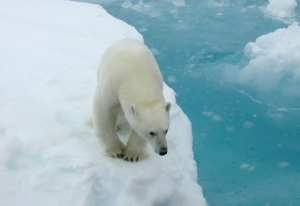
Photo: NOAA
Order Carnivora / Family Ursidae
Ursids are bears. You would not think of a bear as a marine mammal, but polar bears actually spend a lot of time swimming in the ocean, crossing large tracks of it, and hunting seals… “seafood”. This is why they are considered marine mammals.
Polar bears are only found in the Arctic. Interestingly they are not actually white. It would make sense if you lived in the cold arctic to wear a black colored coat to absorb the suns warmth. And it would make sense if a bear was colored black and not white if it lived in the Arctic. But it would also make sense to be white, to hide / camouflage in the Arctic environment. So, to solve this problem… their skin is black, their fur is clear, and the reflecting sun makes them appear white – wah-lah! Pretty cool.
These are carnivores but have a more omnivore molar. Their prey of choice are seals. To stay alive in these cold climates that first, use Bergmann’s rule and grow quite large. Adult male polar bears can reach 10ft in height (when standing) and weigh up to 1000 pounds. Their paws can be 9” wide and they have very large claws. With this size and power, grabbing and killing a seal is not a problem. Sneaking up on him is. The second thing is they eat a high energy rich fatty animal – seal.
In the Arctic the ocean often covered in ice. Seals will dig breathing holes. Polar bears will seek out these breathing holes as an ambush site. They will lie on their bellies and slowly slide towards the hole. Seals will frequently surface for air and take a peek around to see if any bears are nearby. The bears, lying on their stomachs, will sometimes cover their face when this happens. Some biologists believe they are covering the only dark spots on their bodies – their eyes and nose. If the bear can get close enough to the hole, the seal will eventually have to surface again, and the bear can grab him. Seals dig multiple holes in case they DO detect the bear and thus use a different hole further away for the next breath.
Breeding and birth occur on land. Mom must drive dad off after breeding because he has been known to eat the young. This may be due to wanting to mate again or it could be that food is not easy to find in the Arctic and cubs are easier to catch than seals. Not sure…
Unlike most of these marine mammals mentioned, polar bears can be quite dangerous to humans. Any of these mammals can be if you try to mess with them, but polar bears have been known to seek out humans as food. So, people living in bear country in the Arctic must be on their pees-and-ques. Someone once asked me “what is the most dangerous animal in the world? “My response was an angry mother. Do not mess with any mammal who is guarding their young. Little rabbits can be come monsters if you try and mess with their babies.
This was another long one, but as you can guess there is SO MUCH MORE you could say about all of these amazing marine mammals. There is plenty of sites to read more about them.
ACITIVITIES
- Watch an internet video of an alligator walking. Then lie face down on the floor, do a slight push up to get yourself off the ground but keep your hands and feet there (again, like a push-up) now try to walk (crawl) forward – but your chest has to remain off the ground. Now you feel what it is like to be an alligator walking on dry ground. Now, try and “run” like this. See 😊
- Look on the internet for the 10 most intelligent animals. How many are mammals? How do they determine which animals are intelligent?
- Visit a zoo, visit the primate section, find a bench and just sit and watch them interact with each other. These are very intelligent animals.
- Visit a public aquarium where dolphin shows occur. I think you will be amazed at how smart they are.
- Play with your dog or cat. See if you can teach them to do tricks.
- Find an internet video showing the battles between giant squid and sperm whale.
- Find the songs and sounds of whales and dolphins on the internet and listen. It is eerie.
8. Visit one of the wildlife parks in central or south Florida to see a manatee. You MIGHT see one here!
 0
0
